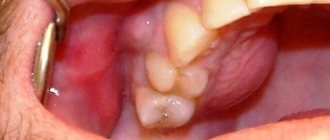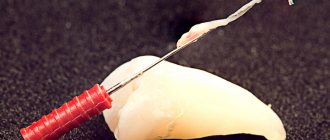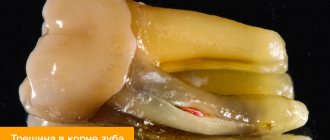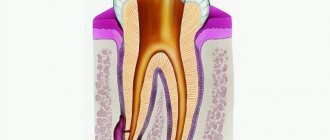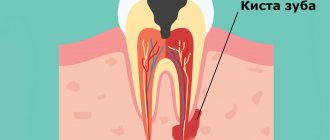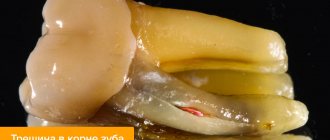Laser treatment of cysts is the best therapeutic method of treatment
Treatment of dental cysts is possible! The specialists of the Bionic Dentis clinic prove this every day.
Dental clinic "Bionic Dentis" is the No. 1 clinic in Russia and the CIS countries for the treatment of dental cysts with a laser . We have the most experience in treating this disease and annually admit more than 1000 patients in this area of activity. The clinic's doctors are recognized in the professional community as experts in laser cyst treatment, conducting educational courses and training specialists in this technique.
Specializing in laser treatment, our dental center presents in the Russian Federation an exclusive technique based on the use of the latest generation dental laser SiroLaser Sirona SIEMENS (Germany).
Russia leads in the number of patients with dental cysts, because the level of root canal treatment in dental clinics in our country is prohibitively low. A public dentist, even acting according to the instructions of the Ministry of Health, works according to an outdated technique, which does not give a positive result in the long term and leads to the development of a dental cyst.
How does a tooth root cyst appear?
The causes of cysts are varied, and among them it is impossible to single out the prevailing ones. So, this may be the result of physical trauma to the maxillofacial bones, or a rare but common medical error, in which the tightness of the root canal was broken, which became the basis for the emergence of a source of infection. A similar situation occurs when a dental crown is installed incorrectly. But the reasons for cyst formation are not limited to this. Untreated infectious diseases (in particular, sinusitis or periodontitis) are no less a provoking factor.
Methods for treating dental cysts
All methods of treating dental cysts can be divided into surgical and therapeutic.
Surgical methods for treating cysts include:
- Cystotomy.
- Cystectomy.
- Resection of the apex of the tooth root.
All these methods are associated with surgical intervention (operation) and require long periods of rehabilitation and healing, and are always accompanied by pain in the postoperative period and massive swelling.
Laser treatment of dental cysts was developed in Germany more than 10 years ago. Over the years, this technique has received worldwide recognition from dentists and patients. The high effectiveness of this treatment method has been proven by more than 900 clinical studies.
But the main problem with surgical treatment methods is that their use has a very high percentage of relapses. Approximately 45% of cases of recurrence of dental cysts.
What methods of removing odontogenic cysts exist?
- Cystotomy.
- Cystectomy.
- Hemisection.
- Laser exposure.
Today, dentists are increasingly resorting to laser surgery, as this method is characterized by low invasiveness and many positive aspects.
Positive aspects of laser exposure:
- The permeability of the vascular walls is reduced, and inflammatory processes in the causative tooth are reduced.
- The process of microcirculation in soft tissues improves.
- The immune response improves.
- The process of tissue regeneration becomes more efficient and metabolism improves.
Unique. 100% channel processing. Laser technique
Let's look at what symptoms indicate that you have a dental cyst:
- Abscess on the gum.
- Flux on the gum.
- It feels like the tooth has grown and is taller than the rest.
- Pain from chewing hard food.
- Fistula on the gum.
These signs are a suppurating tooth cyst. If the described symptoms appear, you should urgently consult a dentist; the fact is that pus can quickly spread through the channels in the bone and reach such vital organs as the eye and ear, which leads to dire consequences.
However, a dental cyst would not be such an insidious disease if it immediately gave clear symptoms. The fact is that in 90 percent of cases, the cyst is completely asymptomatic. The patient does not even suspect that a dangerous disease is maturing in his jaw bone. Often, the patient undergoes a routine examination - a panoramic photograph, which reveals a dental cyst. Let us note right away: even if the cyst does not make itself felt and does not hurt, it must be treated urgently. If left untreated, it leads to serious complications:
- Suppuration of the cyst.
- Compression of nerves, which leads to paresthesia (numbness) of part of the face.
- Destruction of the jaw, up to a fracture of the lower jaw. If the cyst reaches a significant size, the bone becomes brittle and brittle. Even chewing hard food can cause a broken jaw.
- Cysts of the upper jaw in 99% of cases lead to sinusitis. This is a serious and unpleasant disease of the paranasal sinuses that is accompanied by unbearable headaches and nasal congestion.
Diagnosis of symptoms of tooth root cyst
The appearance of a cyst implies the formation of a cavity, which gradually grows while simultaneously filling with pus. This condition can last for a long time, and the patient does not experience pain. A sign suggesting the presence of a cyst is slight pain that occurs when pressing on the gum. Such a symptom only in rare cases becomes a reason to visit a dentist. Basically, it occurs in later stages, when the pain intensifies and becomes nagging, continuous, cannot be relieved with analgesics, and inflammation begins to additionally manifest itself in the form of swelling and swelling of the gums in combination with a persistent unpleasant odor in the oral cavity. Finally, a situation cannot be ruled out in which a fistula occurs - that is, a channel through which the contents of the cavity independently come out.
An effective way to detect a cyst in a timely manner is to conduct an X-ray examination followed by its opening and removal.
It should be noted that at the very beginning the disease poses minimal danger to surrounding tissues, since the cavity itself is reliably isolated by thick walls. However, as pus accumulates, the pressure on the walls increases, creating the possibility of a breakthrough, which can lead to blood poisoning and, in the long term, damage to the structure of the jaw bones. At the same time, the dynamics of cyst development are unpredictable and strictly individual. However, in the presence of other inflammatory processes or infections, in a weakened body the transition to the acute stage can occur quickly.
Particular attention should be paid to early diagnosis of the disease in pregnant women. This is due to the complexity of treatment: during pregnancy, only stabilization of the cyst is possible. If the inflammatory process worsens, the choice of treatment methods is strictly limited. That is why, at the planning stage of pregnancy, it is necessary to undergo a full examination by a dentist.
More details about the technique:
The dentist drills a small hole in the tooth on which the cyst is located. On the front teeth, this hole is located behind the tooth, on the lateral teeth, on top.
The doctor’s goal is to get to the root canals of the tooth, which are located in its center (the pulp of the tooth).
Once access to the nerve is achieved, the dentist removes the contents of the root canal, whether it is an inflamed tooth nerve or an infected tooth canal filling material after poor treatment.
Root canal treatment is not performed blindly. In our clinic, endodontists use a special device: a computerized root canal cleaning system from VDW GOLG (Germany).
Special titanium instruments - MTWO files - with progressive movements under the control of a microprocessor, millimeter by millimeter, clear the root canal, making it smoother, cleaner and straighter. The use of machine computer technology for canal processing in our clinic has a number of advantages:
- reducing the risk of tool breakage and jamming in the tooth canal.
- improving the quality of tooth canal treatment
- increasing the channel processing speed by more than 10 times compared to the manual method.
- eliminates the risk of uncontrolled penetration beyond the apex of the root canal and injury to periapical tissues.
Constant monitoring of canal clearing is carried out by a VDW apex locator (Germany) and the main stages of treatment are controlled using a radiovisiograph XIOS Sirona (Germany), which is installed in each office and allows you to do research without interrupting treatment.
A feature of the diagnostic equipment we use is minimal X-ray exposure to the patient and the resulting high-definition image.
Sometimes it takes 1 - 1.5 hours to clean and unfill the root canal.
After mechanical cleaning and expansion of the canal, they begin its ultrasonic treatment. Scientific research in recent years has proven that microscopic branches extend from a large root canal, which are the main reservoir for bacteria that cause dental cysts. It is not possible to clear these microtubules with files, but our clinic is equipped with a SiroSonic Sirona (Germany) ultrasonic root canal treatment system. This development by the German company SIEMENS ensures the penetration of a disinfectant solution into microscopic tubules and pores, killing microbes there and chemically sterilizing the root canal.
After sterilizing the root canal with chemicals and ultrasound, it is the turn of the SiroLaser laser dental unit. The dentist penetrates the cyst through the root canal and treats it with a laser. Thanks to the unique flexible light guides of our laser, the dentist can penetrate a dental cyst even through a curved canal. This innovation has made the SiroLaser the best in its class.
After laser treatment, the dentist performs laser sterilization of the root canals of the tooth and the cavity in the bone. This allows for 100 percent disinfection of infected tooth tissues, which eliminates the recurrence of a cyst in a given tooth.
After laser sterilization, the drug is installed. This long-acting substance stimulates bone tissue regeneration and tissue disinfection for a period of 4-6 months.
A lighted, especially strong temporary filling or temporary crown is installed on the tooth.
Treatment of dental cysts in 1 visit - we guarantee our patients the use of the world's best achievements in dental treatment.
Unlike the ineffective classical method of treating dental cysts by placing calcium in the root canals, when the patient needs to visit the dental clinic every week for six months, laser treatment of cysts at the Bionic Dentis clinic is carried out in one visit!
After 4-6 months, a radiovisiographic study is performed to confirm tissue regeneration and the healing process in the bone.
The second stage of dental treatment is no less important than laser treatment of a dental cyst.
When is it necessary to remove a cyst along with a tooth?
Indications for tooth extraction:
- The size of the cyst is more than 10 millimeters in diameter;
- The cyst grows into the nasal or maxillary cavity;
- The root of the tooth is tightly fused with the neoplasm;
- Severely damaged tooth;
- The presence of cracks in the root, especially vertical ones;
- The entire root is located in the cavity of the cyst;
- If the process is caused by advanced periodontal disease.
Before the removal procedure, a medical history, radiography or CT scan must be taken. Most often, removing the tooth along with the cyst is the most optimal treatment option and gives the most favorable result. But even such a procedure as tooth extraction requires professional skills and a careful approach from a dental surgeon. Our clinic can provide this professionalism.
- Before surgery, conduction anesthesia with the latest anesthetics is used. Thanks to this, removal will not cause any pain, and properly selected drug therapy will speed up recovery and prevent complications.
- After the anesthesia begins to take effect, the operation begins.
- The gum is peeled away from the walls of the tooth using a rasp or an excavator.
- Apply forceps and begin to loosen.
- Using forceps or an elevator, the tooth is removed from the socket. If immediate removal is not possible, the tooth is cut into several parts and removed.
- The doctor performs curettage of the hole, the cyst cavity is cleaned and the wound is washed with an antiseptic.
- Sutures and iodoform turunda are applied.
- The sutures are removed after 5-7 days, and the turunda must be removed within the period specified by the doctor.
- Prescribe anti-inflammatory and antibiotic therapy, as well as painkillers, if necessary.
3D filling of the root canal of a tooth after laser treatment of a cyst.
To complete the treatment of the tooth and prepare it for restoration, it is necessary to fill the root canals with a permanent material - alpha gutta-percha.
This is a biocompatible medicinal product that does not cause an allergic reaction, does not cause rejection and is ideal for obturation of the root canal.
The dentist re-treats the root canal with an antiseptic using an ultrasound machine. By doing this, he achieves the opening of the entrance to the micro tubules for the filling material.
An alpha gutta-percha pin is lubricated with a sealant and inserted into the root canal. After that, the gutta-percha is heated and pressed into the canal using the VDW BeeFile (Germany) three-dimensional root canal obturation system. Under the pressure of a tool - a plugger, molten liquid gutta-percha penetrates into micro tubules and instantly solidifies there, forming a three-dimensional network - a 3D system of a filled tooth canal.
This method of filling tooth canals is new for the Russian Federation, but this method is the gold standard for obturation of tooth canals in Europe and the USA. Our specialists use this method in 100% of treatment cases, which allows us to avoid recurrence of dental cysts .
As a result of this filling technique, even the most complex root canal systems will be 100% sealed.
There is a simplified analogue of filling canals with gutta-percha, using a standard gutta-percha pin. But it is not effective and cannot compare in terms of results with the original method.
After filling the root canals, a filling, inlay or crown is placed on the tooth.
What can cause the formation of an odontogenic cyst?
As mentioned earlier, the main cause of formation is an infectious process in the tooth.
An infectious process can develop due to a number of reasons:
- Trauma to the jaw bones with damage to blood vessels and nerves located in the pulp.
- Deep caries damaging the pulp chamber.
- A complication after sinusitis affecting the teeth of the frontal group of teeth.
- Errors in endodontic treatment of a tooth when infectious material remains in the canal.
Many patients are afraid to remove a dental cyst. However, if treatment for this pathology is not started in a timely manner, everything can end in disaster. The dental cyst tends to increase in size, destroying the bone walls of the alveoli.
Laser treatment of dental cysts. Beware of fakes.
Recently, several clinics have appeared on the Moscow dental market that promise laser treatment for 3,000 - 5,000 rubles. These clinics, taking advantage of the patients’ ignorance, do not work according to the methodology and on equipment that is not intended for this method of treatment.
Be careful when choosing a clinic for this procedure.
In order for the patient to undergo the original treatment method, the following conditions must be met:
- The clinic must be equipped with the following equipment: computer system for root canal treatment VDW GOLD (Germany), dental laser SiroLaser Sirona, ultrasound dental system SiroSonic Sirona, device for 3D obturation of canals VDW BeeFile (Germany).
- Clinic doctors must be trained in laser technologies from SIRONA SIEMENS.
- Doctors must have a valid state certificate in the specialty: therapeutic dentistry.
Do not hesitate and ask the clinic administrator for all the necessary information regarding your treatment. This will give you the opportunity to choose only a certified clinic and receive a high-quality original method of treating dental cysts with a laser.
Every day we see patients with inflammatory diseases of the jaw bone tissue. We treat patients from Moscow, St. Petersburg and cities of Russia and CIS countries. Due to the fact that treatment takes place in 1 visit, patients from other cities can come to Moscow for treatment for just 1 day.
We have performed this cyst laser treatment on dozens of patients from Europe, since the technique we use is identical to that used in the EU , and the cost is much lower.
By choosing our clinic for cyst treatment, you receive highly technological treatment with a guaranteed result.
How is surgical removal of a dental cyst performed?
How is the operation to remove a dental cyst performed? It includes the following steps:
- Making a diagnosis using x-rays to determine the size of the capsule and the condition of the roots.
- Conducting local anesthesia.
- Cutting and peeling of the gums.
- Drilling out a bony area in the body of the jaw for better access to the formation.
- High-quality cleaning of the contents of the capsule and removal of its shell to prevent further illness.
- Rinsing the cavity with antiseptics.
- In some cases, if necessary, removal of part of the affected root and retrograde filling of the canals.
- Filling the cyst location with osteoplastic material (artificial bone).
- Suturing the mucous membrane.
- After the procedure, it is mandatory to take a control X-ray to ensure that the operation was carried out properly (all infected tissues were removed).
A tooth is removed if its roots are in a cystic formation or if it is completely destroyed.
VIDEO: Method of treating a dental cyst with a SiroLaser SIEMENS laser (Germany) at the Bionic Dentis clinic
This video shows in detail all the stages of a dentist’s work when treating a cyst with a laser. The main points to pay attention to are: computerized root canal cleaning system, ultrasonic root canal cleaning, sterilization of the cyst and root canal with laser radiation.
Watch a video about laser cyst treatment in our clinic:
Indications and contraindications for laser cyst removal
Indications:
Small cysts subject to the following conditions:
- Patency of dental canals;
- The cavity is around the root, and not in the periodontal tissues;
- There are no vertical cracks on the tooth;
- The unit is not very badly damaged.
Contraindications:
- The dental crown is destroyed by more than half;
- The cyst has a diameter of more than 10 mm;
- The infection covers the tissues of the periodontal pocket;
- Root canals are too narrow or crooked.
Cost of treatment of a dental cyst with a SiroLaser SIRONA laser (Germany)
The cost of treating a dental cyst depends on the number of root canals in the tooth.
You can independently determine the number of canals in a tooth using this information:
1st canal in the teeth: Incisors, canines, premolars of the lower jaw, second premolar of the upper jaw.
2 canals in the teeth: First premolar of the upper jaw.
3 canals in teeth: Molars of the upper and lower jaws.
4 canals in teeth: First molars of the upper and lower jaw in 30% of cases.
Warning
: Invalid argument supplied for foreach() in
/var/www/u0695953/data/www/bionicdentis.ru/wp-content/themes/bionic/single-service.php
on line
59
| № | Procedure/manipulation | Price, rub.) |
Laser treatment of dental cysts was introduced in our clinic in 2007. During this time, doctors have accumulated vast experience in using this technique. We can safely say that the greatest experience in the Russian Federation and CIS countries is with the dentists and endodontists of our clinic.
The clinic has accumulated a huge collection of photographs and computed tomography scans of patients before and after treatment.
On this page you can familiarize yourself with the clinical cases of our real patients who underwent successful treatment.
Our statistics: 96% of cysts are successfully cured using the therapeutic method of laser treatment.
Laser treatment of dental cysts at the premium clinic “Bionic Dentis”
We have created all the conditions for your comfortable treatment in our clinic.
Convenient location in the center of Moscow.
Personal approach to each patient.
Classic clinic interior.
The best European equipment.
Modern techniques and expert doctors.
Ozerov Petr Vladimirovich
Chief physician. Dentist, implantologist, orthopedist, surgeon. Laser dentistry specialist
More details
Werner Elena Vladimirovna
Dentist periodontist
More details
Eremina Anna Arturovna
Dentist therapist
More details
Tooth root cyst in children
The disease has features and varieties that are characteristic strictly for children. First of all, we are talking about formations that arise and go away on their own, without complications: in the form of a rash that appears on the gums, as well as the so-called “Epstein’s pearl”. Both varieties do not pose a danger due to the absence of purulent masses, which means that the cavity is infected. In addition, they may not occur at all, being only some of the phenomena accompanying the development of the child.
The situation is different with the appearance of a cyst during the growth of teeth (both milk and molars). In this case, the resulting cavities are infected, and given the previously described asymptomatic nature of the disease in the early stages, the most reliable method of determining its presence is regular visits to the doctor. This allows for successful treatment at the very beginning of the development of the cyst, saving the tooth in almost 100 percent of cases.
Clinical case of cyst treatment with laser. year 2014.
Patient Maria N, 36 years old, went to the dental clinic at her place of residence with complaints of gumboil, pain in the gums, a feeling of fullness, increased body temperature and general malaise. A panoramic photograph was examined at the patient’s clinic. Based on the results of the study, a diagnosis was made - a cyst of teeth 12 and 13. Dentists recommend that the patient remove both teeth and undergo a cystectomy.
The patient contacted several private dental centers, where she was also offered to remove teeth 13 and 12.
The patient did not agree with the proposed treatment and contacted the Bionic Dentis clinic for a consultation about the possibility of saving her teeth and treating the cyst on teeth 12 and 13 with a laser.
The clinic's dentist confirmed the possibility of treating the cyst with a laser.
The patient decided to undergo treatment at the Bionic Dentis clinic.
12 and 13 were treated using the SiroLaser SIRONA laser (Germany) according to the standard protocol.
Within 8 months, complete regeneration of bone tissue occurred and the cyst successfully disappeared.
3D root canal filling was performed. A restoration has been installed on the tooth - light filling FILTEC ULTIMATE
Where can I remove a dental cyst without extracting a tooth?
If you are concerned about this problem, then we invite you to visit the Implantmaster dental clinic to get rid of a cyst on a tooth by treatment or tooth extraction. For you - qualified specialists, all the necessary ultra-modern equipment and reasonable prices.
The price for removing a dental cyst is determined by the services of an endodontist and a surgeon. Endodontic treatment is required with a microscope, including anesthesia, materials, etc., starts from 6,500 rubles. Removal of the cyst by a surgeon is paid separately—about 10,000 rubles. This cost includes all surgical procedures. Lifetime guarantee for treatment at Implantmaster.
Author:
Results of cyst treatment with laser “BEFORE” and “AFTER”
We have collected a huge collection of dental x-rays and computed tomography scans showing the condition of the tooth with a cyst before treatment and after laser treatment.
Our experience in treating dental cysts with laser is the largest in Moscow.
You can be convinced that this technique can cure even teeth with large cysts.
All pictures are clickable.
Over 10 years of work, we have accumulated vast experience in treating dental cysts with laser.
During this time, the clinic's doctors became experts in the treatment of this disease.
We are proud that our dental colleagues from many Moscow and regional clinics trust us by referring their patients to us with complex cases, which we successfully handle!
By choosing the Bionic Dentis clinic to treat a dental cyst with a laser, you will save your tooth from removal. Cysts treated by us do not recur, and teeth last for many decades after treatment.
What is a dental cyst and how to remove it?
Radical dental cyst is a complex chronic disease. It has its own shell and is filled with purulent contents. The disease progresses on the roots and under the gum. A cyst appears when early infectious inflammation, which is based on pathogenic microflora, is not treated.
Removal of a dental cyst is performed surgically . The tumor can grow, affecting the gums and cheeks from the inside of the mouth. In some cases, sepsis may develop.
All this makes it difficult for the patient to function normally. To cure the disease, conservative methods are used:
- at the beginning of the procedure, the doctor informs the patient about the possible consequences (it is worth making this the first point);
- the doctor performs an opening of the dental cavity;
- cleansing the cavity from affected tissues;
- treatment with solutions of antibiotics and antiseptics;
- Then, within half an hour, the tooth cyst is removed without removing the tooth .
The patient will have a chance for recovery and further normal life. The main feature of this disease is its asymptomatic course. The patient may remain unaware for a long time. The consequences of this disease can lead to another complex process - sinusitis (if the cyst is located near the sinuses). It is imperative to monitor the cleanliness of the oral cavity and the condition of the gums, and also come to the doctor for sanitation on time.



